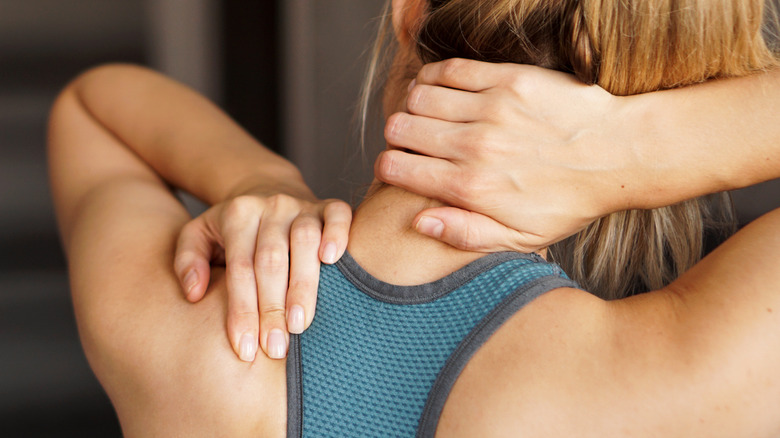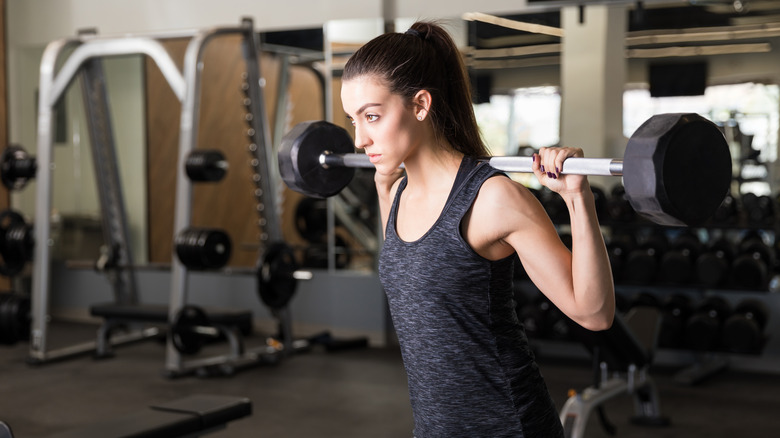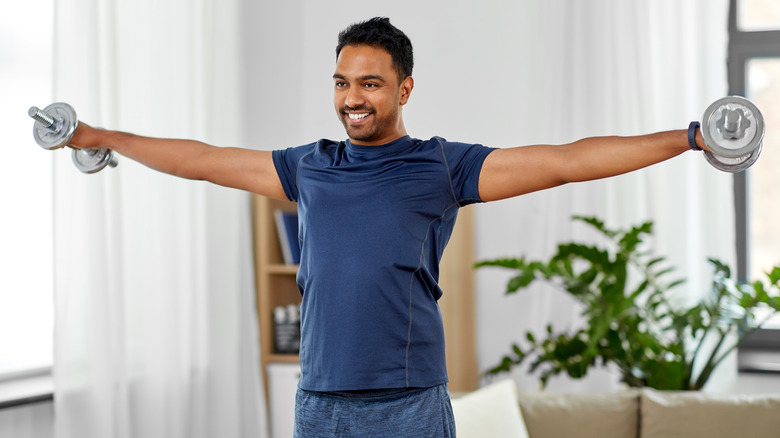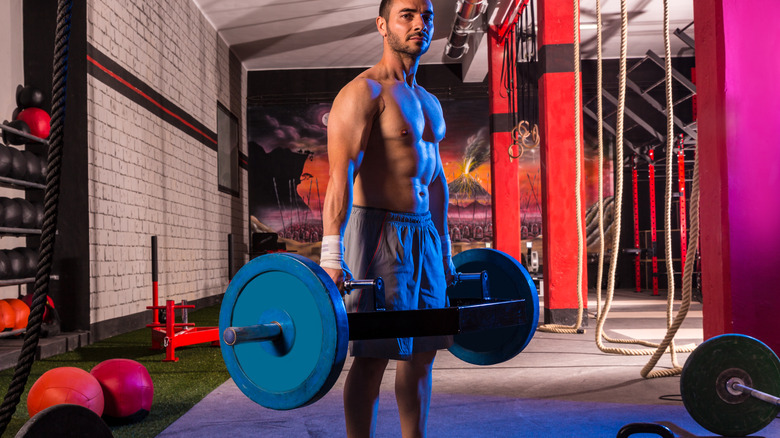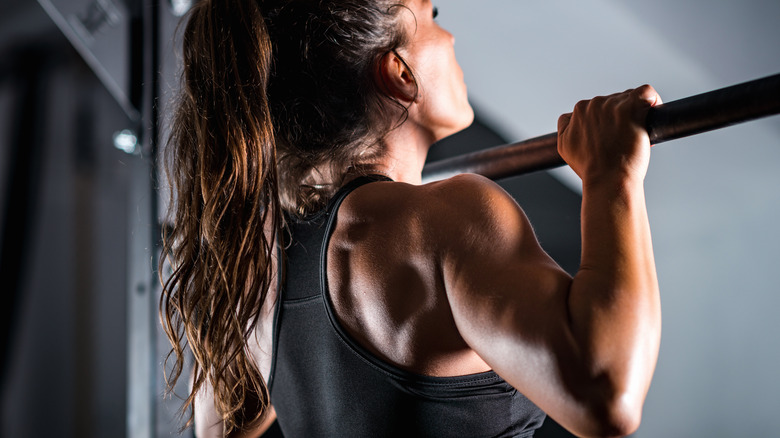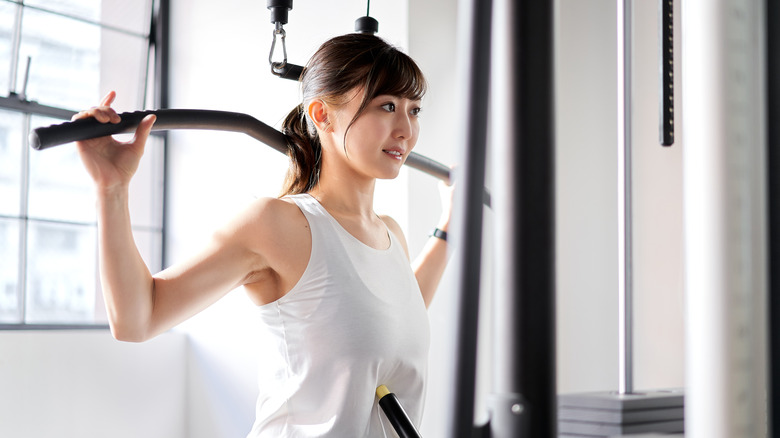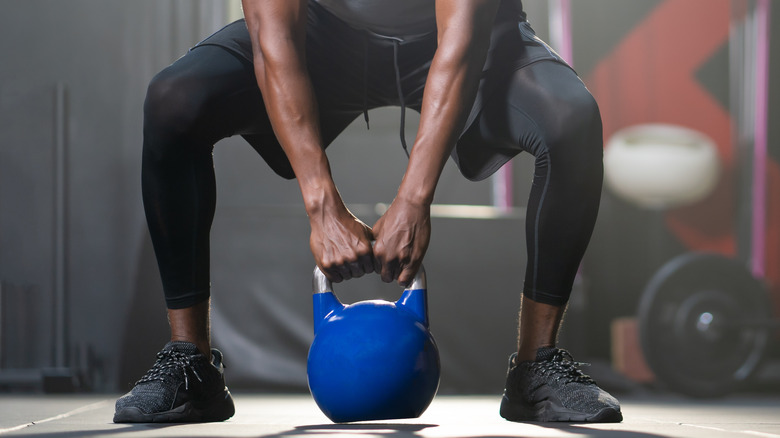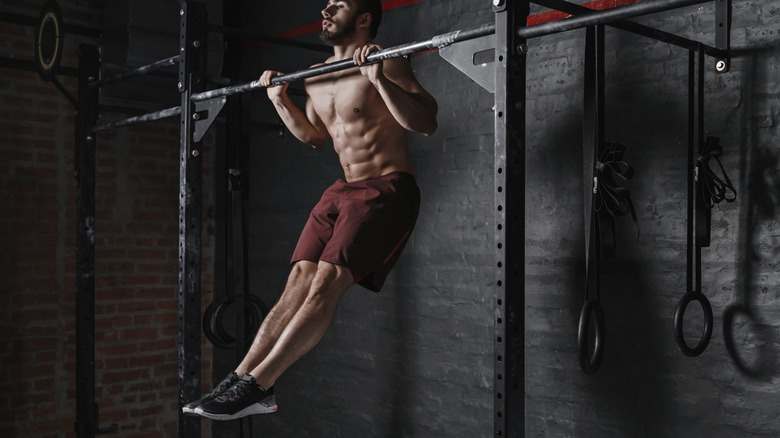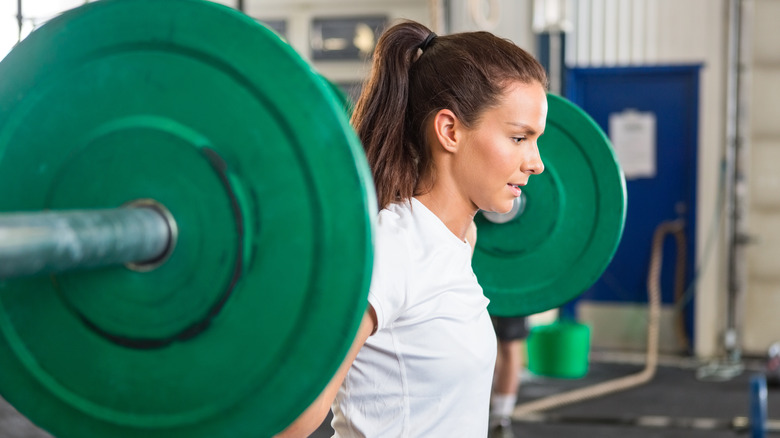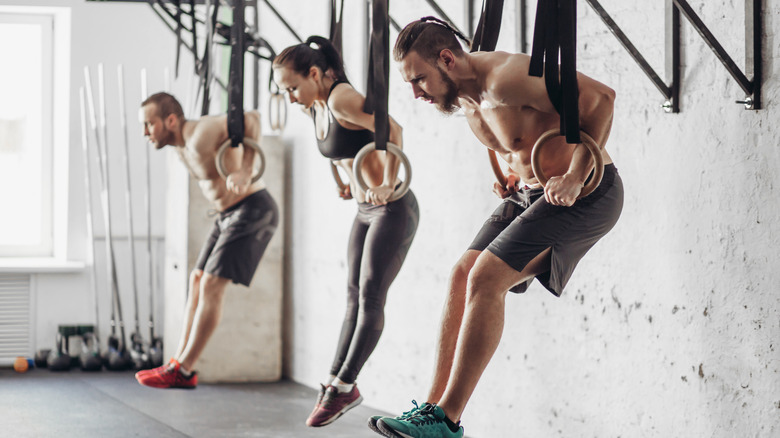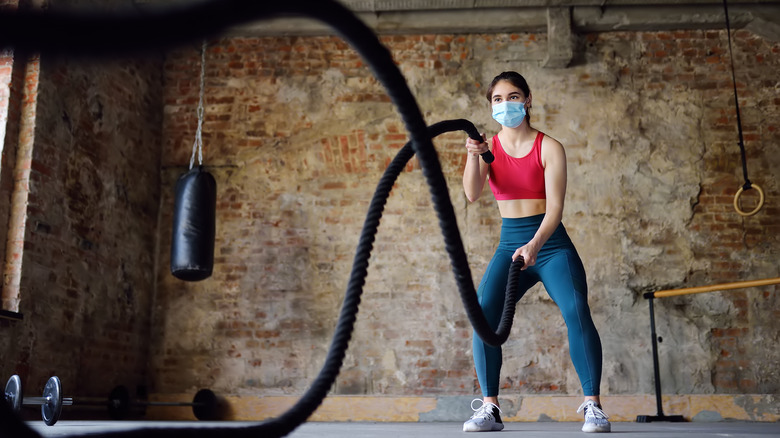The Worst Exercises For Your Shoulders
It pays to keep your shoulders in good shape. Your shoulder muscles play an enormous part in supporting the healthy movement of the most dynamic joint on your body, as Healthline states. These 20 separate muscles combine to keep your arms and shoulders operating effectively. Aside from this, having toned shoulder muscles just looks and feels pretty good — which, let's be honest, is probably a big reason why so much money is spent on free weights every year. A whopping $410,500,000 spent on free weights alone in the US in 2020, per Statista.
As with all muscles, working out your shoulders effectively can see them strengthen healthily and steadily. Working them out ineffectively, however, can lead to a world of trouble — and the troublesome news is that there are a lot of exercises out there that may put your shoulders in harm's way, particularly when combined with less-than-perfect form. But how do you separate the good from the bad when it comes to shoulder exercises? Well, we've done the hard work for you. Let's take a look at the worst exercises for your shoulders.
The upright row can do way more harm than good
A favorite of jacked bodybuilders and casual workout fans alike, the upright row is a move you've probably seen someone doing in the gym. But if you're thinking of trying it out yourself, don't rush into it.
According to physical therapist, strength coach, and John Rusin Fitness Systems owner John Rusin, while an upright row can be effective for developing parts of your deltoids, the motion of the movement makes it risky to do (via Stack). When performing an upright row, an internal rotation occurs in the shoulder from the upper arm — which, unless you're blessed with flawless posture, technique, and perfectly healthy shoulders, can be troublesome. "A vast majority of people don't have those requisites, so it becomes an injurious motion for them," states Rusin.
And as Rusin explains, the whole thing about upright rows is that they solely train your delts. But most people's delts are already pretty developed anyway, and are effectively trained by loads of other exercises like bench presses and push-ups. There's no reason to isolate them too much a lot of the time, but if you're inclined to do so, Rusin recommends a banded dumbbell lateral raise as a safer alternative to the upright row.
Behind-the-neck presses can strain your rotator cuff
If you're performing a barbell press, whatever you do, we implore you, don't bring it to rest behind your head.
While the behind-the-neck press can be a common sight at the gym, according to certified strength and conditioning specialist and "Fitness Hacks for Over 50" author K. Aleisha Fetters, it can end in disaster (per Livestrong). "People sometimes do the press behind the neck because, at the bottom position, it puts more tension on the traps and delts," states Fetters. Unfortunately, doing this "comes with a sizable risk of shoulder injury without having more payoff than other shoulder press variations," leading Fetters to feel that this move isn't worth the time or potential hassle.
According to Healthline, a behind-the-neck press specifically places strain on (and thus endangers) your rotator cuff muscles, which play a large role in stabilizing the shoulder joint. Instead of a behind-the-neck press, try performing a standard shoulder press with dumbbells, raising the weights above your head from the side while holding them parallel to your head and neck. Performing a behind-the-neck press with dumbbells instead of a barbell can also help to reduce injury risk with this move.
Lateral raises can cause compression
Lateral raises are a staple in a lot of people's workout routines, but this seemingly simple move has a wide margin for error. And when they go wrong, they go really wrong, explains Jacksonville Orthopedia Institute, which names the move as one of the worst shoulder exercises you can do. The move can be particularly dangerous for your rotator cuff muscles, which can be compressed against your shoulder bone during the movement of the exercise, leading to the increased likelihood of rotator cuff injury.
However, while performing a lateral raise incorrectly can lead to a rapid trip to the emergency department, it can be a very effective exercise to strengthen the shoulders when done correctly, says Men's Health. You just have to keep a few essentials in mind. First, reduce the amount of weight you think you need. Otherwise, as Men's Health fitness director and certified strength and conditioning specialist Ebenezer Samuels says, you'll just end up using momentum to jerk the weight up to its highest position.
To relieve some of the strain placed on your rotator cuffs, Samuels recommends turning your thumbs slightly towards the sky when your weights are coming to rest by the side of your body. Doing this will help create space for your rotator cuff tendons, stopping them from being squished, and helping prevent long-term injury.
You don't need to do a rolling shrug
We've all seen it: That enormous guy in the gym, shrugging a set of dumbbells (usually loudly enough for everyone to hear him) and, for some reason, rolling his shoulders forward pretty ostentatiously as he releases them. Well, friends, we're here to tell you one thing. That roll? You don't need it.
"There's no need to roll your shoulders all over the place. If anything, all that shoulder rolling can take emphasis off your traps," states certified strength and conditioning specialist Ebenezer Samuels for Men's Health. And not only is it unnecessary, but rolling your shoulder while you perform shrugs can expose your shoulders to injury, because your joints can grind together when you do it (per Men's Journal).
So how do you do a shrug? It's as simple as up-and-down, folks. As Samuels explains, your traps, which you're trying to train with the movement, operate on vertical motion, so keeping your shrugs simple is the best way forward. Stand with your neck in a neutral position and your weights by your sides, and shrug your shoulders up. Hold at the top, and slowly lower them down.
Regular dips can place strain on your bursa
Ah, the dip: The source of so much controversy. While a dip can be an effective exercise — with the key appeal of it being that you can perform it pretty much anywhere with no weights required — it can also be hugely problematic for your shoulders. In fact, it has gained the reputation to prove it.
As Synergy Physio explains, dips can place an unusual amount of strain on your rotator cuff tendons and shoulder bursa, with the range of motion often forcing the bursa into a pinched position. Over time, this move can lead to pain and injury, and wear and tear to your rotator cuff.
However, if you're determined to include dips in your exercise routine, keeping your form as perfect as possible can help to reduce injury. T-Nation explains that to avoid injury, keep your body in a hinged position and avoid hunching over the dip bars. You can assist yourself in doing this by hollowing out your core. Activating the lats while you dip also helps to support your posture and maintain your spine's alignment, which then means that your shoulders are more likely to be in the correct position for the movement.
Beware of kipping pull-ups if you don't have the power for them
The unstoppable rise of CrossFit has brought a range of exercise variations into everyday use, and while some of these might offer serious fitness benefits, others aren't so great. One of these is the kipping pull-up, which, according to Fitness Quest 10 owner and certified strength and conditioning specialist Todd Durkin (via Stack), isn't all it's cracked up to be.
"Even though kipping seems easier because you use your momentum, it's actually a more dangerous movement on the shoulder joint." Durkin explains that because a lot of people who attempt this movement don't have enough strength or stability in their shoulders to do this pretty hardcore movement, "they end up getting injured."
Bear in mind that, as Men's Health states, even CrossFit recommends that you should only do a kipping pull-up after you've nailed your regular pull-up. Unless you have enough strength to do the basic move, you'll end up with an injury on your hands pretty fast. Instead, try and build up your pull-up muscles by keeping it simple and performing slow, controlled pull-ups to start. You don't have to jump straight to kipping pull-ups just because the cool kids are all doing it.
Behind-the-head lat pull-downs can place tension on your joints
Sometimes, when training primary muscles with exercises, other muscles that are involved can bear the brunt and potentially end up under strain or injured. This is the case with behind-the-head lat pull-downs, which can provide a serious burn to your back muscles and serious potential for injury to your shoulders, according to doctor of physical therapy and Florida Orthopedic Institute therapist Jessica Malpelli (per CNN). "The lat pull-down places a lot of stress on the anterior joint capsule of the shoulder," Malpelli states, due to the behind-the-head position the bar ends up in. Over time, this can "eventually lead to impingement or even rotator cuff tears."
That's no reason to banish the lat pull-down from your exercise regime forever, though. As Coach Magazine explains, there's a safe and simple way to incorporate lat pull-downs into your workout. Simply make sure the bar comes down in front of your chest. Make sure you hold the bar with a wide grip and retract your shoulder blades as you pull it down, squeezing your lats at the bottom of the movement. Try not to lean back when you're doing it, however tempting it is.
A kettlebell swing's wide range of motion can cause problems
You may look all cool and strong during a kettlebell swing, but be wary of what it's actually doing to your shoulders. This super-dynamic movement is a prime suspect for causing shoulder pain, says doctor of physical therapy, personal trainer, and president of JAG Physical Therapy John Gallucci Jr. to CNN. Gallucci Jr. states that "because of the speed and the force of the swinging motion of the kettlebell, the shoulder is at significant risk for injury." Without proper form during the movement, the wide range of motion "could result in rotator cuff injury and/or inflammation of other structures in the shoulder."
As such, if you're keeping the kettlebell swing in your workout routine, make sure your form is on point. According to Coach Magazine, start by setting your feet shoulder-width apart, and place the kettlebell between them and a little in front of you. Focus on hingeing at the hips to pick the kettlebell up, letting it swing between your legs to create the power you need to push it out in front of you to shoulder height. Allow the kettlebell to drop back to its position between your legs, and swing away. Make sure you start with a manageable weight and try to avoid involving your upper body too much during the movement, as this can cause potential strain and injury to your back muscles.
Be careful how you perform regular pull-ups
Mastering a regular pull-up is a key step in any person's fitness journey. But in your attempts to do so, make sure you keep your shoulders in mind, as performing pull-ups incorrectly or too often can put them at risk of injury.
Pull-ups aren't necessarily bad for your shoulders, as Livestrong states, and the exercise bears far less risk of shoulder injury than some other upper-body exercises. The movement, however, can place a lot of load on your rotator cuff muscles due to the overhead positioning of the arms, increasing your likelihood of injuring them.
The best way to avoid this is to not only make sure your pull-up form is perfect but also do some additional training of your rotator cuff muscles to reduce the risk of injury during movements that involve them. Simple exercises, like a reverse fly using light weights or a lawnmower pull using a resistance band, can help both to strengthen your rotator cuff muscles to perform heavier-duty movements and to restore motion and flexibility following a rotator cuff injury (per Healthline).
Olympic lifts aren't for the faint-hearted
Ever watched Olympic athletes hoisting unbelievably heavy weights over their heads and thought, "I could do that?" If you have (and if you're like us, you've probably done so from the comfort of your couch, with your feet up and a sense of misplaced smugness), we beg you to read this before you buy the biggest barbell you can afford.
Although Olympic lifts are designed to be safe for the shoulders, that's only the case if your form is on point, according to Stack. And lowering the weight from over your head instead of dropping it means that "the shoulders can take a beating from decelerating a heavy load as it's brought down," says certified strength and conditioning specialist and Coach Rozy Performance owner Mark Roozen.
If you've never done Olympic lifts before, it's seriously advisable to build up to doing them gently. "To do the full lifts safely requires very good mobility, flexibility and balance," states strength and conditioning coach Alex Adams (via Coach Magazine). Also, practice makes perfect. Instead of jumping straight in, focus on building strength up with movements like the front squat or bent-over row, increasing your overall power until you're lifting like the best of them.
The range of motion in ring dips can cause injury
Imagine a gymnast twirling through the air with a ring in each hand, exuding power and skill. Makes you want to give it a go, right? It's likely for this reason that ring dips have become so popular as an upper-body strengthener — but beware of your shoulders when doing them.
As Mike Reinold, physical therapist and owner of Boston-based Champion PT and Performance, says to Men's Health, the "full, extreme end range of motion" that happens during a ring rip puts your shoulders in jeopardy and can cause a rotator cuff injury quite easily.
If you've got your heart set on mastering ring dips, Reinold advises not to rush things. Instead, your dips should be done in a controlled and safe manner to avoid the likelihood of pushing things too far too soon. Rather than jumping straight on the rings, building up your strength with incline dips can be a good starting point, according to Men's Health. This dip variation gives additional protection to your shoulders while helping to build your pectoral muscles.
Battle ropes may look cool -- but they could seriously hurt your shoulders
Battle ropes are not for the faint of heart — and may not be your shoulder's best friend. While battle ropes are a novel and dynamic way to build muscle and strength, using them also bears a lot of risks if you don't have the prerequisite shoulder mobility and strength due to the intense movement of the exercise, says Muscle and Fitness. Going at it too hard too soon can end up in a nasty shoulder injury pretty fast.
However, there's an argument to be made that battle ropes aren't inherently bad — it's all about how you use them, states U.S. Marine Corps Staff Sergeant and Onnit's Master Battle Rope Trainer Aaron Guyett (via Vice). "Putting your shoulder in a vulnerable position can be a problem. But at the same time, sports like climbing, boxing, and throwing put your shoulder in a vulnerable position multiple times throughout the activity," he points out. According to Guyett, the most important thing is to maintain control and form throughout a battle ropes workout. And if your power isn't quite there yet, focus on building up shoulder strength with gentler exercises first.
So what are the best exercises for your shoulders?
With the number of exercises out there that come with a risk for shoulder damage, you might be wondering if there are actually any that are worth doing. Well, the good news is, there are! Although any exercise can be potentially dangerous if performed incorrectly, prioritizing certain moves can help to keep your shoulders as safe as possible.
A good place to start for a safe shoulder workout is with a three-move circuit of halos, half-kneeling Arnold presses, and thumbs-up lateral raises (via Men's Health). This trio of exercises will not only help you get a serious pump in your shoulders, but also build up strength around the shoulders. This will provide additional support and power around the joint that will help reduce injury in other movements and exercises.
Another important thing to remember is that you don't always have to go for the heaviest weight you can manage. When building up strength and endurance, a lighter weight will still serve this purpose.

